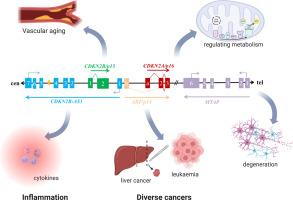揭示CDKN2B-AS1:驱动年龄相关疾病的功能性长链非编码RNA
IF 0.9
Q4 GENETICS & HEREDITY
引用次数: 0
摘要
衰老是一种生理功能的逐渐下降,在细胞和器官水平上都与衰老密切相关。新兴研究越来越强调长链非编码rna (lncRNAs)在调节细胞衰老中的作用,lncRNAs是一类长度超过200个核苷酸的rna,缺乏蛋白质编码潜力。其中,周期蛋白依赖性激酶抑制剂2B反义RNA 1 (CDKN2B-AS1)是一种位于INK4位点的反义lncRNA,引起了人们的极大关注。CDKN2B-AS1水平升高已在多种肿瘤组织中被观察到,其抑制已被证明可抑制癌细胞的增殖、侵袭和迁移。最近的研究进一步表明,lncRNA CDKN2B-AS1作为竞争内源性RNA (ceRNA),影响炎症途径和调节葡萄糖代谢,参与心血管疾病(cvd)、糖尿病、癌症、关节炎和骨质疏松症等年龄相关疾病(ARDs)。破译CDKN2B-AS1介导衰老过程的分子机制可以增强我们对衰老和ARD干预的理解,并为衰老和ARD干预提供新的途径。这篇综述深入研究了CDKN2B-AS1影响ARD进展的分子机制,提供了新的生物标志物和潜在的诊断工具,同时总结了在这种情况下的临床治疗策略。本文章由计算机程序翻译,如有差异,请以英文原文为准。

Unveiling CDKN2B-AS1: The functional long noncoding RNA driving age-related diseases
Senescence, a gradual decline in physiological functions, is closely linked to aging at both the cellular and organ levels. Emerging research has increasingly highlighted the role of long noncoding RNAs (lncRNAs)—a class of RNAs longer than 200 nucleotides that lack protein-coding potential—in regulating cellular senescence. Among them, cyclin-dependent kinase inhibitor 2B antisense RNA 1 (CDKN2B-AS1), an antisense lncRNA located at the INK4 locus, has gained significant attention. Elevated levels of CDKN2B-AS1 have been observed in various tumor tissues, where its suppression has been shown to inhibit the proliferation, invasion, and migration of cancer cells. Recent studies have further implicated lncRNA CDKN2B-AS1 in age-related diseases (ARDs) including cardiovascular diseases (CVDs), diabetes, cancer, arthritis, and osteoporosis, by functioning as competing endogenous RNA (ceRNA), influencing inflammatory pathways, and regulating glucose metabolism. Deciphering the molecular mechanisms by which CDKN2B-AS1 mediates aging processes can enhance our understanding and provide new avenues for aging and ARD interventions. This review delved into the molecular mechanisms by which CDKN2B-AS1 influences ARD progression, offering insights into novel biomarkers and potential diagnostic tools while summarizing clinical treatment strategies in this context.
求助全文
通过发布文献求助,成功后即可免费获取论文全文。
去求助
来源期刊

Gene Reports
Biochemistry, Genetics and Molecular Biology-Genetics
CiteScore
3.30
自引率
7.70%
发文量
246
审稿时长
49 days
期刊介绍:
Gene Reports publishes papers that focus on the regulation, expression, function and evolution of genes in all biological contexts, including all prokaryotic and eukaryotic organisms, as well as viruses. Gene Reports strives to be a very diverse journal and topics in all fields will be considered for publication. Although not limited to the following, some general topics include: DNA Organization, Replication & Evolution -Focus on genomic DNA (chromosomal organization, comparative genomics, DNA replication, DNA repair, mobile DNA, mitochondrial DNA, chloroplast DNA). Expression & Function - Focus on functional RNAs (microRNAs, tRNAs, rRNAs, mRNA splicing, alternative polyadenylation) Regulation - Focus on processes that mediate gene-read out (epigenetics, chromatin, histone code, transcription, translation, protein degradation). Cell Signaling - Focus on mechanisms that control information flow into the nucleus to control gene expression (kinase and phosphatase pathways controlled by extra-cellular ligands, Wnt, Notch, TGFbeta/BMPs, FGFs, IGFs etc.) Profiling of gene expression and genetic variation - Focus on high throughput approaches (e.g., DeepSeq, ChIP-Seq, Affymetrix microarrays, proteomics) that define gene regulatory circuitry, molecular pathways and protein/protein networks. Genetics - Focus on development in model organisms (e.g., mouse, frog, fruit fly, worm), human genetic variation, population genetics, as well as agricultural and veterinary genetics. Molecular Pathology & Regenerative Medicine - Focus on the deregulation of molecular processes in human diseases and mechanisms supporting regeneration of tissues through pluripotent or multipotent stem cells.
 求助内容:
求助内容: 应助结果提醒方式:
应助结果提醒方式:


